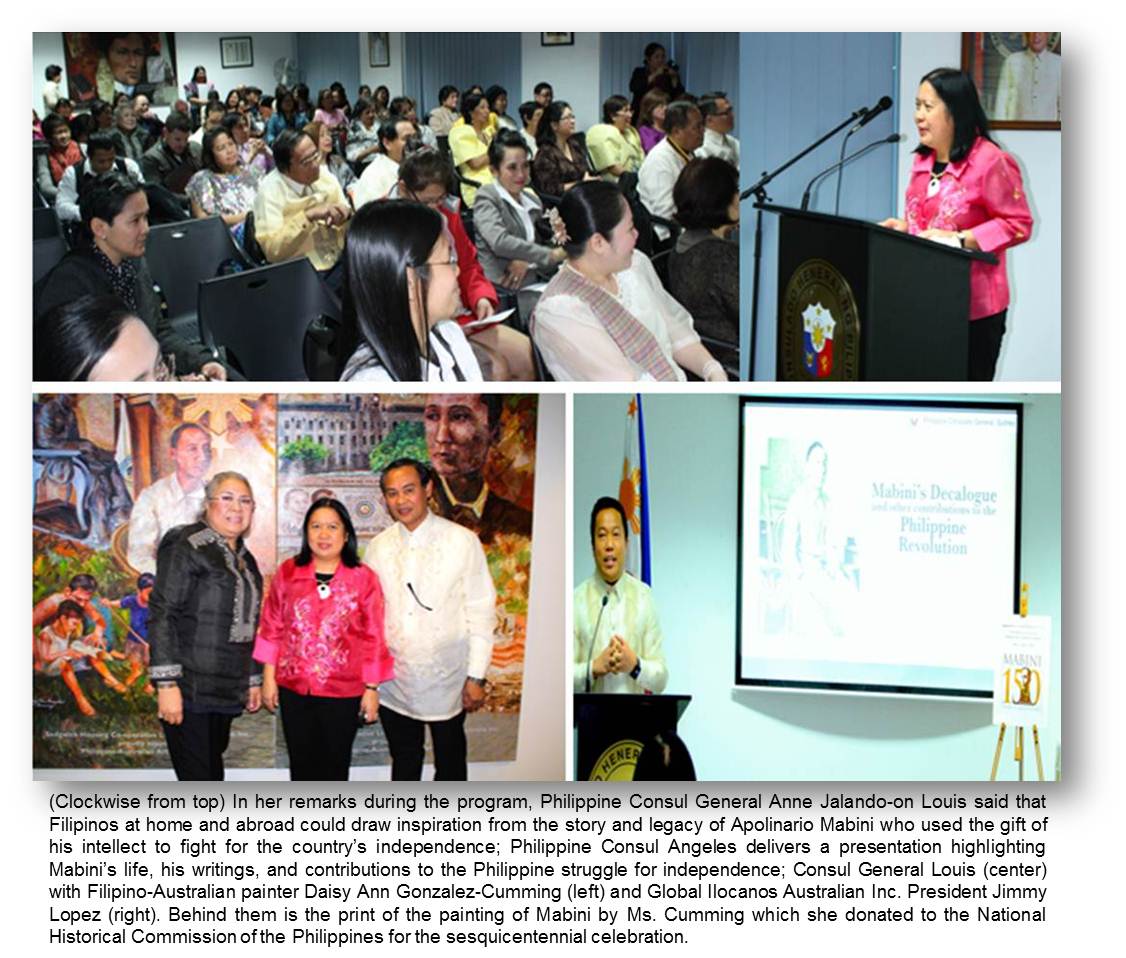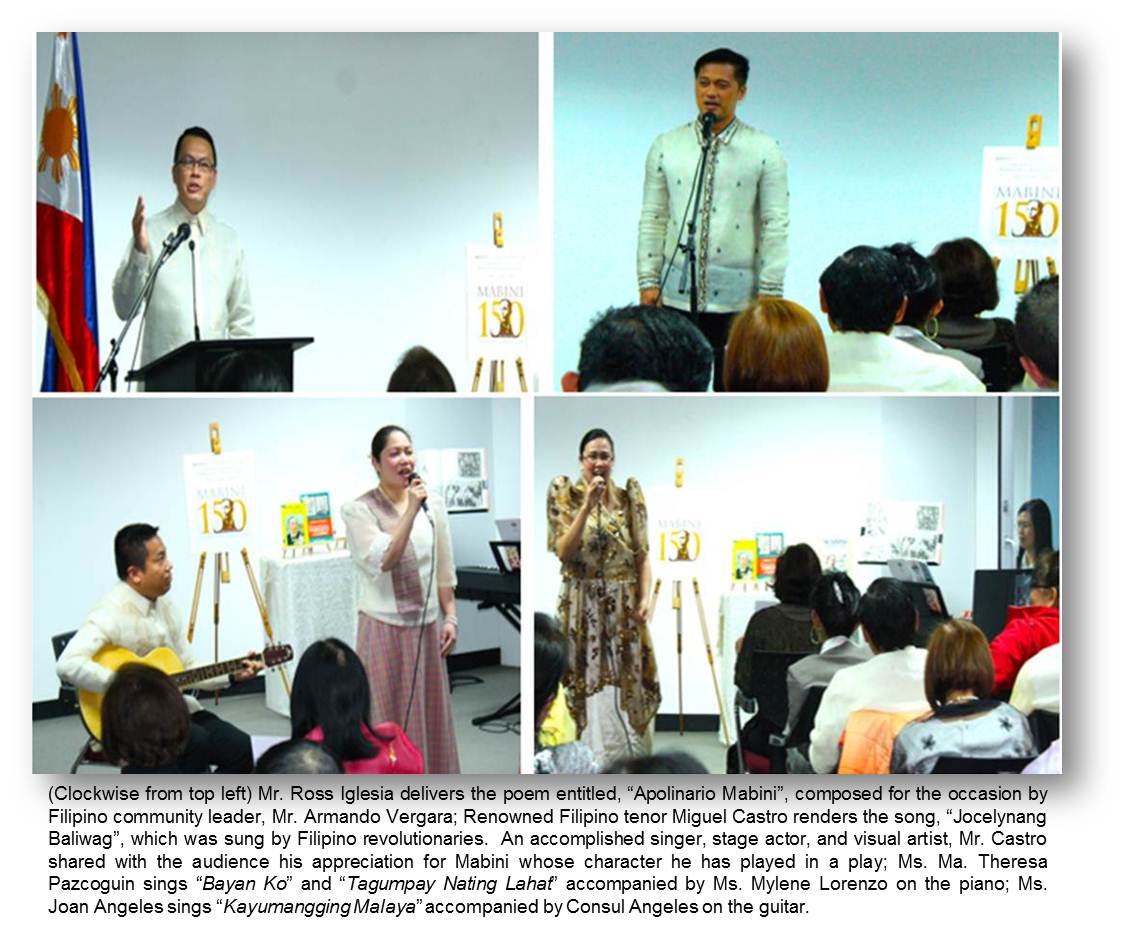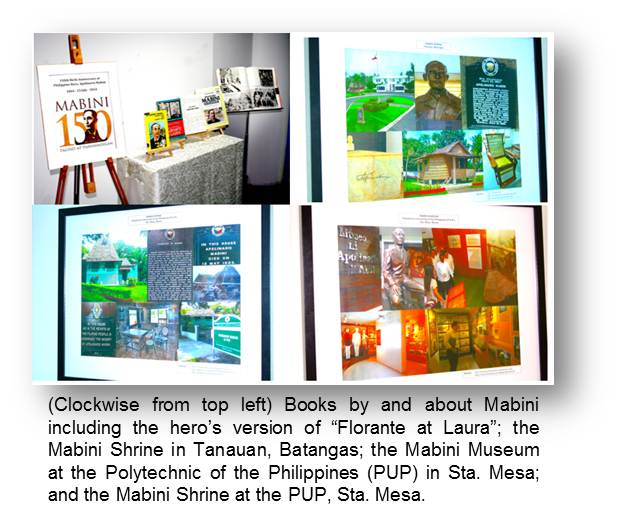
06 August 2014 - The Philippine Consulate General in Sydney hosted a program entitled, “Tribute to Mabini,” at the Consulate’s Bulwagang Rizal on July 26 in commemoration of the 150th Birth Anniversary of Apolinario Mabini. Around 80 Filipino community leaders and representatives from the community media attended the event. Also present were Tourism Attaché Consuelo G. Jones and Special Trade Representative Emmanuel Ang.
In her remarks, Philippine Consul General Anne Jalando-on Louis highlighted the challenges faced by Apolinario Mabini, who had to deal with a physically debilitating condition at the height of the Philippine Revolution. She also underscored Mabini’s integrity and exemplary character as shaped by his humble beginnings and desire to succeed and to serve his country despite his disability.
Consul Marford Angeles gave a presentation entitled, “Mabini’s Decalogue and other contributions to the Philippine Revolution,” which focused on the theme of the sesquicentennial celebration, “Talino at Paninindigan.” Consul Angeles described Mabini’s life and achievements as a student and his contributions to the Philippine Revolution, including “The True Decalogue” which he wrote and which provided the Revolution’s moral foundation. Consul Angeles also spoke of Mabini’s unwavering patriotism and fight for Philippine independence even in prison and throughout his exile in Guam.

During the program, Filipino-Australian painter Daisy Ann Gonzales-Cumming made a presentation on the ceremonies held in Manila on June 18 to mark the unveiling and turn-over of her painting of Mabini to the National Historical Commission of the Philippines (NHCP). Ms. Cumming’s painting is entitled, “Kahiman May Kapansanan, Naging Utak ng Kalayaan”. Ms. Cumming, together with the Filipino community associations Plaza Filipino, Global Ilocanos Australian Inc., Sedgwick Cooperative Ltd., and NARRA Cooperative Ltd., presented to the Consulate a print of the painting which is displayed at the hallway of the Consulate. Ms. Cumming likewise donated a painting of Andres Bonifacio to the National Commission for Culture and the Arts (NCCA) in celebration of the hero’s sesquicentennial last year, as well as a painting of Dr. Jose Rizal on the occasion of Rizal’s sesquicentennial anniversary in 2012.
Mr. Miguel Castro, renowned Filipino tenor and visual artist, performed the songs “Jocelynang Baliwag,” considered to be the Philippine Revolution’s kundiman and composed by Jose Zulueta, “Pag-ibig sa Tinubuang Lupa”, based on a poem by Andres Bonifacio and composed by Bonifacio Abdon and lyricist Patricio Mariano, and “Ika’y Lupang Hinirang, Perlas ng Silangan” composed by Percy Icban and arranged by Erick Sta. Maria and Mitch Morala. Mr. Castro spoke of his deep respect and admiration for Apolinario Mabini which grew when he starred in the one-act play “Mabini" written by Rene Villanueva and directed by Jun Flavier Pablo and staged by the Tribune Filipino Cultural Foundation in cooperation with the Intramuros Administration.
Songs were also rendered by Ms. Joan Angeles and Ms. Ma. Theresa Pazcoguin. Ms. Angeles sang “Kayumangging Malaya”, a stirring patriotic song composed by Lucio San Pedro, accompanied on the guitar by her husband, Consul Angeles. Ms. Pazcoguin sang the well-loved “Bayan Ko” composed by Constancio de Guzman and the inspirational song, “Tagumpay Nating Lahat” composed by Gary Granada, accompanied on the piano by Ms. Mylene Lorenzo.
Mr. Armando Vergara, who is known in the Filipino community for his poetic talent, wrote a poem entitled, “Apolinario Mabini,” dedicated to the hero’s sacrifice for his countrymen, which was delivered during the program by Mr. Ross Iglesia.
 Showcased at the event were publications on Apolinario Mabini from the Consulate’s Resource Centre, as well as framed photos of the Mabini Shrine in Tanauan, Batangas and the Mabini Shrine and Museum at the Polytechnic of the Philippines (PUP) in Sta. Mesa, Manila. The photos will be displayed at the Consulate throughout the year.
Showcased at the event were publications on Apolinario Mabini from the Consulate’s Resource Centre, as well as framed photos of the Mabini Shrine in Tanauan, Batangas and the Mabini Shrine and Museum at the Polytechnic of the Philippines (PUP) in Sta. Mesa, Manila. The photos will be displayed at the Consulate throughout the year.
The guests continued their discussions on Mabini and the important place he holds in Philippine history during the refreshments that followed the program. END

